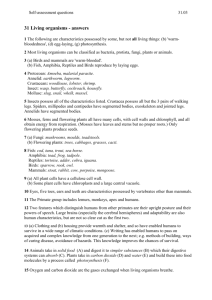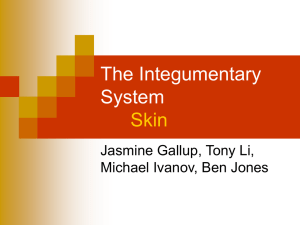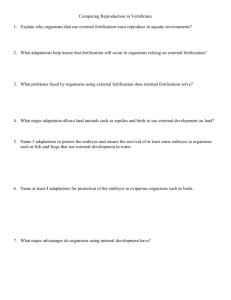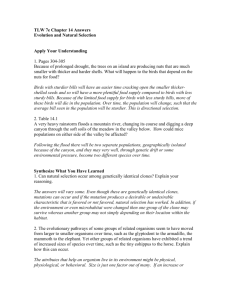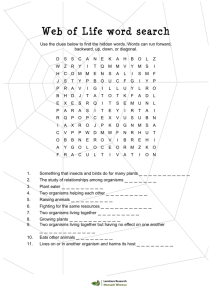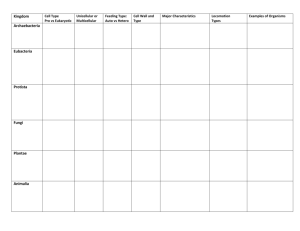theory of evolution
advertisement
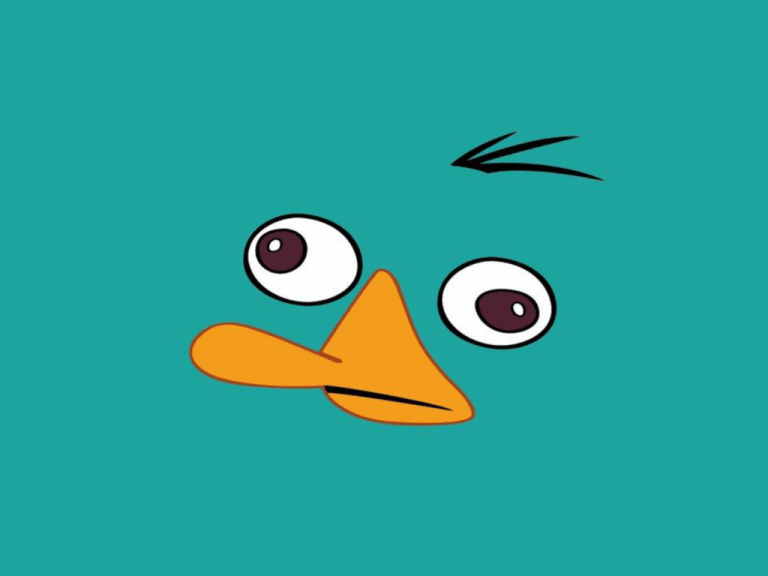
PERRY POPS BIOLOGYYYYYY YYYYYY 2.0 It’s back! EVOLUTION A development that involves the series of gradual adaptations by which organisms have become more complicated over many generations Jean-Baptiste Lamarck • Theory of Use & Disuse • Theory of Acquired Traits (acquired traits can be acquired by the following generation) • Environmental influences can affect phenotype THEORY OF EVOLUTION • Founded by Charles Darwin & Alfred Russel Wallace • Concepts: – Reproduction: organisms reproduce more than what’s enough to replace them (but population = fairly constant) – Competition: organisms must compete for scarce resources (Struggle for Existence) – Variation: within populations = variety of characteristics others will be able to survive more effectively (Survival of the Fittest) – Adaptation: organisms adapt in order to survive and reproduce (Natural Selection) EVIDENCES OF EVOLUTION • Fossils: preserved remains; show gradual changes in evolution • Vestigial structures: remains of used-to-be useful organs (appendix, coccyx/tailbone) • Geographical distribution: organisms with similar characteristics but belong to diff. continents = common ancestors • Comparative biochemistry: proteins/genetic sequences as basis for evolutionary relationships • Comparative Anatomy Structure: Homologous – same design w/ diff. functions; Analogous – diff. designs w/ same functions • Comparative embryology: similarities in the development of offspring (reptiles – birds – mammals) TAXONOMY TAXONOMY: ANIMAL KINGDOM Vertebrates (with backbones) Invertebrates (without backbones) Pisces (fish) Coelenterates (jellyfish, hydra) Amphibians (frogs) Reptiles (snakes, turtles) Aves (birds) Mammals Platyhelminthes (flatworms) Nematodes (roundworms) Mollusks (slugs, snails) Echinoderms (starfish) Arthropods Crustaceans (crabs, shrimps) Myriapods (centipedes) Insects Arachnids (spiders, scorpions) ECOLOGY • Study of the relationship of plants and animals to their physical and biological environment • Biosphere – Thin mantle of life covering the earth • Biomes – Broad units of vegetation influenced by latitude, elevation, moisture and temperature regimes KINDS OF BIOMES BIOME MOISTURE TEMPERATURE VEGETATION ANIMALS Arctic Tundra Dry/wet seasons Cold all year round Shrubs, grasses, lichens, mosses Birds, insects, mammals Deciduous Forest Low, distributed throughout the year Warm summers, cold winters Trees, shrubs, herbs, lichens, mosses Birds, insects, mammals Desert Sporadic, highly localized Great daily range (extremes) Trees, shrubs, succulents small mammals, birds, reptiles Taiga Moderate, varies throughout year Cold winters, cool summers Evergreen, tamarack Birds, mammals Tropical Savannah Wet/dry seaons hot Trees, vines, stranglers, fungi Small mammals, birds, insects Tropical Rainforest Wet/short dry season hot Trees, vines, stranglers, fungi Small mammals , birds, insects Marine Environment The open ocean, litoral regions, benthic regions, rocky shores, sandy shores, estuaries, associated tidal marshes ECOSYSTEM • Locale or habitat as an integrated whole factors: biotic (living) and abiotic (non-living) • Habitat – where biotic and abiotic factors can be found; have their own animals and plants – Community – all living things in the habitat – Population – members of the same species in the same habitat – Niche – the role of an organism in a habitat • Members of a community depend on: – Energy: (in the form of) food that flows from the community’ originally from the sun – Nutrients: recycled within a community and an ecosystem FEEDING TYPES • Autotrophs – make their own food; the source of energy (producers) • Heterotrophs – cannot make their own food (consumers) – Herbivores: primary consumers that eat plants – Carnivores: secondary consumers that eat primary consumers • Omnivores – can eat plants and meat – Scavengers – feed on dead organisms (vultures, hyenas) • Oligotrophs – producers/synthesize their own food in extreme conditions, when food is scarce act as consumers under normal conditions (conditional autotrophs/heterotrophs) • Decomposers – recycle nutrients from dead organisms (fungi and bacteria) FOOD CHAIN The passing on of energy/ nutrients that are recycled within an ecosystem (Food webs – interconnected food chains) HUMANS AND THE ENVIRONMENT • Pollution from fossil fuels: burning of fuels by industry, power stations, and vehicles • Deforestation: trees can be harvested and replaced BUT rate of harvesting is much greater than the rate of replacing • Toxin accumulation: mainly due to nonspecific/specific herbicides and insecticides COMMUNITY INTERACTIONS • Competition: organisms compete for shared resources with short supply; more successful organisms survive • Predation: consumption of one organism, plant/animal, by the other • Parasitism: two organisms living together; one benefits at the expense of the other • Co-evolution: evolution of one species depends on part of another’s evolution • Succession and climax communities: gradual changes in vegetation over time PLANTS • PLANT LIFE CYCLE – Annual • any plant that germinates, grows, flowers, sets seed, and dies within one year – Biennial • plants that flower, set seed, and die in their second year – Perennial • plants that flower and set seed for two or more years • PLANT CELL TYPES – Parenchyma • cell walls are uniformly thin and can either be meristematic (capable of cell division) or permanent. • carry out physiological functions such as photosynthesis, storage and secretion, and wound healing – Collenchyma • made up of unevenly thickened primary cell walls • functions as support tissue in young, growing parts of plants (strength and mechanical support) – Sclerenchyma • cells have secondary cell walls containing lignin • important for strength and support • PLANT TISSUE SYSTEMS – Ground • fundamental tissue system in plants • consists of parenchyma, collenchyma, & sclerenchyma tissues – Dermal • consists of the epidermis • some parts contain stomata (openings which gases are exchanged with the atmosphere) or cuticle (to prevent water loss) • epidermis is later on converted to peridermis (made up of dead, waterproofed cells, mainly cork tissue) – Vascular • xylem: conduction of water and dissolved nutrients – conducting cells: tracheid and vessel elements • phloem: conduction of food – primary cells: sieve elements • TROPISMS – growth responses of plants to obtain enough water, minerals, and sunlight – Phototropism • with respect to a light source • plant naturally grows towards the brightest light source – Geotropism • with respect to gravity – Hydrotropism • with respect to water • Stems – usually above the ground – increases in length through apical meristem at the stem tip • Leaves – functions in photosynthesis, stores food and water – sites of transpiration and provides structural support for the plant • Flowers – reproductive organs of certain plants • Roots – anchors plant to its substrate and absorbs water and minerals – types: fibrous (monocot) and tap (dicot) roots BODY CAVITIES FRONT (VENTRAL/ANTENOR) BACK (DORSAL/POSTERIOR) Pericardial Cavity houses the heart (that is located in the thorax/chest) Cranial Cavity Protects the brain Thoraic Cavity Between the neck and the abdomen; contains the lungs and the heart Spinal Cavity Protects the spinal cord Abdominopelvic Cavity Houses the digestive, excretory & reproductive systems BODY TISSUES A. Epithelial – protects the body from injuries/infection: skin B. Connective – support and hold parts of the body together: A. Fibrous, elastic, blood, lymph B. tendon = bone to muscle, ligament = bone to bone C. Muscular – contrast and relax: A. striated (joined together), B. smooth (involuntary, internal organs), C. cardiac (involuntary, heart) D. Nervous – transfer information: neurons ganglia (nerve nuclei) MUSCULAR SYSTEM • Allows manipulation of the environment, movement, facial expression, posture; produces heat (= 620 muscles!) SKELETAL SYSTEM • Protects/supports body organs; framework for muscles (= movement); • bone marrows = blood production; stores minerals (=206 bones!) • Joint – connection between bones • Cartilage – between bones (shock absorber) • Ligaments – holds bone to bone • Tendons – muscle to bone ENDOCRINE SYSTEM Glands secrete hormones regulate processes GLAND HORMONE FUNCTION Pituitary (“Master Gland”) Oxytocin Smooth muscle control, labor, milk Vasopressin/ADH Kidney/urine control Pineal Melatonin Regulates wake/sleep patterns Thyroxine Increases metabolism Calcitonin Controls calcium intake Gluccorticoids Increase blood sugar Epinephrine & Norepinephrine “fight or flight” hormone/adrenalin Thyroid Adrenal (Suprarenal) ENDOCRINE SYSTEM GLAND HORMONE FUNCTION Insulin Lowers blood sugar Glucagon Releases glucose from the liver Parathyroid hormone Increase calcium levels Pancreas Parathyroid Estrogen Ovaries Secondary sex characteristics for females Progesterone Testes Testosterone Secondary sex characteristics for males CIRCULATORY SYSTEM • Blood vessels – transports blood which carries O2, CO2, nutrients, wastes, etc. – veins: carries blood towards the heart – arteries: carries blood away from the heart – capillaries: exchange vessels • Blood – complex substance which carries substances through cells • Heart – acts as a pump which moves the blood through a network of tubes called blood vessels • Pulmonary Circulation – carries deoxygenated blood away from the heart and to the lungs, and returns oxygenated blood back to the heart • Systemic Circulation – carries oxygenated blood away from the heart to the body, and returns deoxygenated blood back to the heart DIGESTIVE SYSTEM • breaks food down into absorbable units that enter the blood for distribution of cells • indigestible foodstuff are eliminated as feces • PATHWAY OF FOOD – mouth • mechanical digestion: mastication – salivary glands • will turn into bolus – pharynx • passage of food and air • epiglottis closes over the trachea – esophagus – stomach • through peristalsis – small intestine – large intestine – rectum • waste materials • OTHER PARTS – liver • functions in metabolism • produces bile – gallbladder • fat digestion • stores bile – pancreas • secretes pancreatic juice and insulin EXCRETORY SYSTEM • eliminates nitrogenous wastes from the body • regulates water, electrolyte, and acidbase balance of the body • detoxification of blood EXCRETORY SYSTEM • Skin – sudiferous (sweat glands) – sebaceous (oil glands) – helps remove the additional wastes produced by these glands • Liver – detoxifies and breaks down chemicals, poisons, and other toxins • Urinary System – Kidney • • • • Nephron – functional unit of a kidney; acts as filters Glomerulus Bowman’s capsule Loops of Henle – Ureter • propels urine from the kidneys to the urinary bladder – Urethra • connects urinary bladder to the outside of the body – Bladder • collects urine excreted by the kidneys prior to disposal by urination RESPIRATORY SYSTEM • keeps blood constantly supplied with oxygen and removes carbon dioxide • the gaseous exchange occur through the walls of the air sacs of the lungs • Respiration – carried on by the expansion and contraction of the lungs • Breathing – process which delivers oxygen to the body’s cells and removes carbon dioxide produced from cellular respiration AIR PATHWAY • • • • • • mouth or nose pharynx larynx trachea bronchus lungs – bronchiole – alveoli FEMALE REPR DUCTIVE SYSTEM **overall function: production of offspring • ovaries produce eggs and female sex hormones; mammary glands produce milk MALE REPR DUCTIVE SYSTEM • testes produce sperm cells and male sex hormones • ducts and glands aid in delivery of viable sperm to the female reproductive tract • uterus PARTS – passes the male’s sperm through to the fallopian tubes – hosts developing fetus – also known as the womb • ovaries – produces the egg cells • vagina – also known as the birth canal • cervix • fallopian tubes/oviducts • reproductive tract PARTS • penis – male copulatory organ • testicles – produces semen and sperm cells – epididymis: maturation and storage for sperm – seminiferous tubules: where sperm cells are produced • scrotum – holds and protects the testes • vas deferens – sperm duct PARTS • accessory glands – provide fluids that lubricate the duct system and nourish the sperm cells – seminal vesicles • produces fructose – provides sperm cells energy and aids in their motility – prostate gland • responsible for the proof of semen – bulbourethral glands • also called Cowper glands
